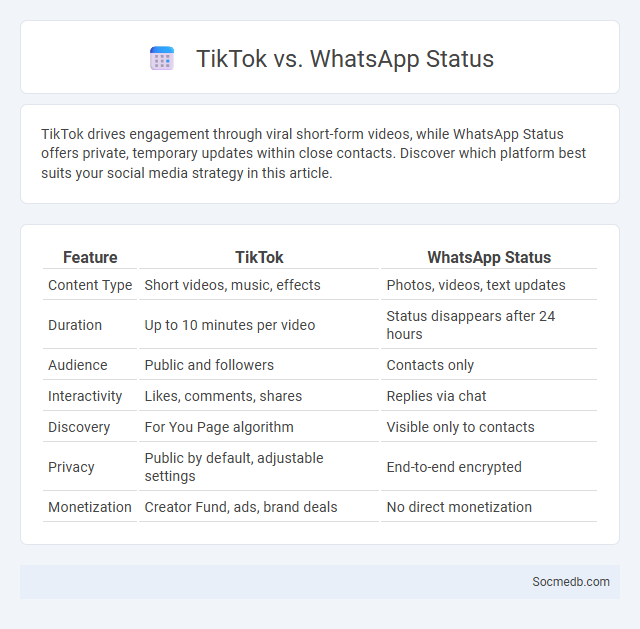
Photo illustration: TikTok vs WhatsApp Status
TikTok drives engagement through viral short-form videos, while WhatsApp Status offers private, temporary updates within close contacts. Discover which platform best suits your social media strategy in this article.
Table of Comparison
| Feature | TikTok | WhatsApp Status |
|---|---|---|
| Content Type | Short videos, music, effects | Photos, videos, text updates |
| Duration | Up to 10 minutes per video | Status disappears after 24 hours |
| Audience | Public and followers | Contacts only |
| Interactivity | Likes, comments, shares | Replies via chat |
| Discovery | For You Page algorithm | Visible only to contacts |
| Privacy | Public by default, adjustable settings | End-to-end encrypted |
| Monetization | Creator Fund, ads, brand deals | No direct monetization |
Introduction: The Rise of Social Video and Story Features
Social video and story features have revolutionized social media by enabling quick, engaging, and visually rich content sharing. Platforms like Instagram, TikTok, and Snapchat prioritize ephemeral videos and interactive stories that boost user engagement and real-time connections. You can leverage these dynamic tools to enhance your brand visibility and foster authentic audience interactions.
TikTok Overview: Features, Audience, and Engagement
TikTok is a leading social media platform known for short-form video content, featuring tools like filters, effects, and music integration that enhance creative expression. Its user base primarily consists of Gen Z and Millennials, with over 1 billion active monthly users globally, making it a hub for viral trends and influencer marketing. High engagement rates stem from TikTok's algorithm-driven personalized feed, fostering rapid content discovery and interactive features such as duets and challenges.
WhatsApp Status: Private Sharing and Daily Updates
WhatsApp Status enables private sharing by allowing you to control who views your updates through customizable privacy settings. This feature supports daily updates that disappear after 24 hours, ensuring your shared moments remain timely and relevant. Managing your audience on WhatsApp Status enhances your social media experience by maintaining privacy while engaging with close contacts.
Comparing User Demographics: TikTok vs WhatsApp
TikTok's user base predominantly consists of Gen Z, with over 60% of users aged between 16-24, while WhatsApp appeals to a broader demographic spanning from teenagers to older adults, reflecting its global adoption for personal and professional communication. Your choice between the two platforms should consider TikTok's emphasis on short-form video content favored by younger audiences versus WhatsApp's versatile messaging features popular among all age groups. This demographic contrast directly influences content style, engagement strategies, and marketing potential across these social media giants.
Content Formats: Short-Form Video vs. Stories
Short-form video and stories dominate social media content formats, each offering unique engagement opportunities for brands and creators. Short-form videos, typically under 60 seconds, capitalize on trends and viral potential through platforms like TikTok and Instagram Reels, boosting reach with dynamic visuals and quick consumption. Stories, available on Instagram, Facebook, and Snapchat, provide ephemeral, authentic snapshots that foster real-time interaction and closer audience connection via features like polls, stickers, and swipe-up links.
Algorithms and Reach: TikTok’s Feed vs WhatsApp’s Contacts
TikTok's algorithm leverages user behavior, including watch time and engagement rates, to curate a highly personalized feed that maximizes content discovery beyond your immediate network. WhatsApp, in contrast, relies on direct contacts for message reach, limiting interaction primarily to existing social connections without algorithmic content amplification. Understanding these differences enables you to strategize content distribution effectively across platforms with distinct reach potentials.
Cross-Platform Promotion Strategies
Cross-platform promotion strategies leverage multiple social media channels like Instagram, Facebook, Twitter, and LinkedIn to maximize audience reach and engagement. Utilizing tailored content formats and consistent messaging across platforms enhances brand visibility while driving traffic to target pages or campaigns. Effective use of analytics tools enables optimization of posting times and content types, boosting conversion rates and follower growth.
Best Practices for Repurposing Content Across Platforms
Repurposing content across social media platforms maximizes reach and engagement while saving time and resources. Tailor your content to fit each platform's unique format and audience preferences, such as converting blog posts into infographics for Instagram or short videos for TikTok. You can boost your brand's visibility and maintain consistent messaging by strategically adapting and resharing high-performing content.
Measuring Success: Analytics and Metrics Comparison
Measuring success on social media relies heavily on analytics and metrics such as engagement rate, reach, impressions, and conversion rates, which provide insights into audience behavior and campaign effectiveness. Platforms like Facebook Insights, Twitter Analytics, and Instagram Insights offer specialized tools to track performance, enabling businesses to optimize content strategies based on real-time data. Comparing these metrics across platforms highlights nuances in user interactions, allowing for more strategic decision-making and targeted marketing efforts.
Conclusion: Choosing the Right Platform for Your Goals
Selecting the right social media platform depends on your specific goals, target audience, and content style. Platforms like Instagram and TikTok excel in visual storytelling, while LinkedIn suits professional networking and B2B marketing. Understanding platform demographics and engagement metrics ensures you maximize your reach and impact effectively.
 socmedb.com
socmedb.com